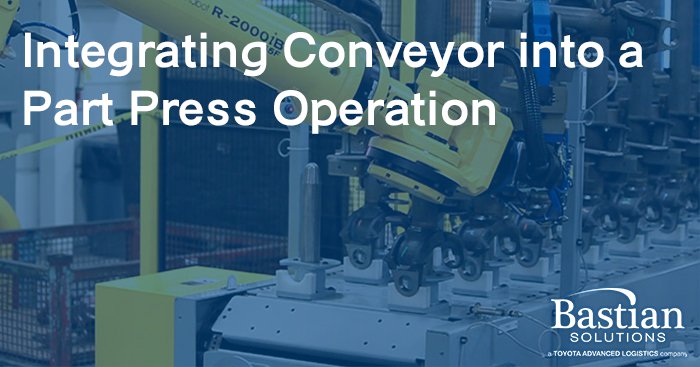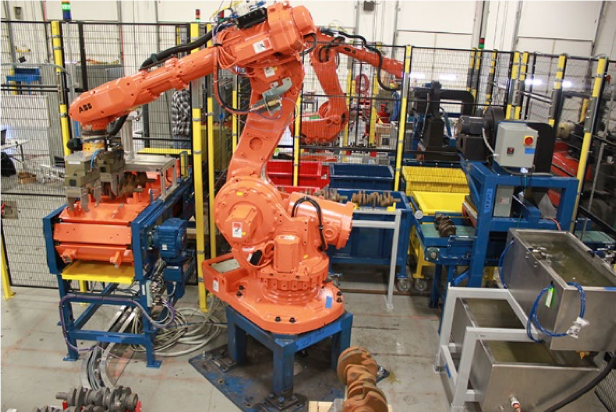
Integrating Conveyor into a Part Press Operation
David Musch | 25 January 2019
Automation is the most effective way to increase productivity and efficiency in a manufacturing operation. However, the best automated solution will be different from one application to the next due to the unique needs and factors involved.
Industrial robots are one common automation solution taking over more interaction between parts and manufacturing processes. To keep the operators safe, parts are often fed into a cell by some type of conveyor. The robot picks the parts off and places them in a machine for processing. However, in many operations, robots may not be needed at all.
When trying to suggest the proper automated solution for an application, it’s important to ask enough questions, so that you are guided toward a robust solution.
Some questions to ask if considering automation for your manufacturing process:
- What are the parts?
- What is the cycle time for assembly?
- What level of accuracy is required?
- Will the assembly take place on the conveyor or will the part be taken off?
- Are there any contaminants involved with the assembly, like oils or shavings?
- What size are the parts?
- How much space is required for the robot to do its work?
Case Study: Automating a Press Operation
Let’s look at an operation that presses two rings together with 400 pounds of pressure required. The original process for this type of operation was for an operator to pick the outer ring out of a bin and move it to a fixtured platen. They would then get the inner ring from another bin and place it into position. Next, they would stand back and push two buttons to perform the pressing operation, then return the finished assembly to another parts bin.
Each of these processes took time. If the company is looking for greater productivity without automation, multiple lines would be needed. However, that may not be the most effective, cost-efficient solution. There is also a question of how accurate this type of manual operation would be, how much damage would occur to finished parts, and so on. To determine the best solution, we start by exploring options. 
Options for Press Operations Automation
Below are some options available to make the pressing operation more efficient.
- Convey the parts from their manufacturing point to the press cell for assembly. Then convey the finished product to a packaging location. This would eliminate the need for a fork truck and reduce damage from loading and unloading with a bin. However, it wouldn’t eliminate human error or quality issues.
- Implement a robot to increase throughput and accuracy. This would create new questions as to how accurate the part positioning needs to be at the conveyor/robot interface. How do we achieve this accuracy? Can the robot pick out of bins or can the rings be conveyed from where they are manufactured? If the robot can pick the parts out of a bin, would it need vision and what would the cost be vs. accurate locating? In today’s world this is the go-to technology.
- Put a fixture on a pallet to convey the parts from manufacture to the assembly station. Parts #1 and #2 would be loaded on the pallet at point of manufacture then moved to the press. Sensors detect whether the parts are in the correct position, if so they are sent on, if not they are diverted to a reject spur. The approved parts and pallet pull into a locate station which accurately locates (0.001 mm) and lifts the pallet off the conveyor. A lockout is positioned to support the pallet/part as the press occurs. The finished part then moves to a finished goods unload station.
The advantages of this last design are that it is as accurate as any of the other options, less expensive, and causes less damage to the finished goods. The disadvantage was that it required more space, as the pallets needed to return to the starting position.
After exploring all available options, this last solution was selected. Using pallets and a locating station saved about 1/2 in cost for the owner, while keeping the throughput as high as possible. The type and style of conveyor in this case was driven by the size of the product.
At Bastian Solutions, we are experts in finding the best solutions for maximizing efficiency and effectiveness at a cost that makes sense – no matter the unique needs of your operation. If your company is looking to improve its manufacturing or distribution operations by adding conveyors or automation, contact us today.
I am a Regional Manager with Bastian Solutions, overseeing the Michigan and northern Ohio field offices. With over 25 years of experience in managing projects and selling conveyor systems, I enjoy closely working with our Field Application Engineers and Project Engineers and their varied customers.
Comments
No comments have been posted to this Blog Post
Leave a Reply
Your email address will not be published.
Comment
Thank you for your comment.